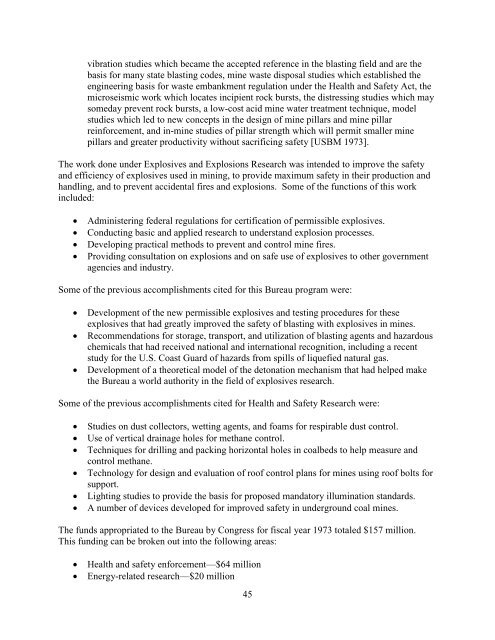One Hundred Years of Federal Mining Safety and Health Research
One Hundred Years of Federal Mining Safety and Health Research
One Hundred Years of Federal Mining Safety and Health Research
- No tags were found...
You also want an ePaper? Increase the reach of your titles
YUMPU automatically turns print PDFs into web optimized ePapers that Google loves.
vibration studies which became the accepted reference in the blasting field <strong>and</strong> are the<br />
basis for many state blasting codes, mine waste disposal studies which established the<br />
engineering basis for waste embankment regulation under the <strong>Health</strong> <strong>and</strong> <strong>Safety</strong> Act, the<br />
microseismic work which locates incipient rock bursts, the distressing studies which may<br />
someday prevent rock bursts, a low-cost acid mine water treatment technique, model<br />
studies which led to new concepts in the design <strong>of</strong> mine pillars <strong>and</strong> mine pillar<br />
reinforcement, <strong>and</strong> in-mine studies <strong>of</strong> pillar strength which will permit smaller mine<br />
pillars <strong>and</strong> greater productivity without sacrificing safety [USBM 1973].<br />
The work done under Explosives <strong>and</strong> Explosions <strong>Research</strong> was intended to improve the safety<br />
<strong>and</strong> efficiency <strong>of</strong> explosives used in mining, to provide maximum safety in their production <strong>and</strong><br />
h<strong>and</strong>ling, <strong>and</strong> to prevent accidental fires <strong>and</strong> explosions. Some <strong>of</strong> the functions <strong>of</strong> this work<br />
included:<br />
• Administering federal regulations for certification <strong>of</strong> permissible explosives.<br />
• Conducting basic <strong>and</strong> applied research to underst<strong>and</strong> explosion processes.<br />
• Developing practical methods to prevent <strong>and</strong> control mine fires.<br />
• Providing consultation on explosions <strong>and</strong> on safe use <strong>of</strong> explosives to other government<br />
agencies <strong>and</strong> industry.<br />
Some <strong>of</strong> the previous accomplishments cited for this Bureau program were:<br />
• Development <strong>of</strong> the new permissible explosives <strong>and</strong> testing procedures for these<br />
explosives that had greatly improved the safety <strong>of</strong> blasting with explosives in mines.<br />
• Recommendations for storage, transport, <strong>and</strong> utilization <strong>of</strong> blasting agents <strong>and</strong> hazardous<br />
chemicals that had received national <strong>and</strong> international recognition, including a recent<br />
study for the U.S. Coast Guard <strong>of</strong> hazards from spills <strong>of</strong> liquefied natural gas.<br />
• Development <strong>of</strong> a theoretical model <strong>of</strong> the detonation mechanism that had helped make<br />
the Bureau a world authority in the field <strong>of</strong> explosives research.<br />
Some <strong>of</strong> the previous accomplishments cited for <strong>Health</strong> <strong>and</strong> <strong>Safety</strong> <strong>Research</strong> were:<br />
• Studies on dust collectors, wetting agents, <strong>and</strong> foams for respirable dust control.<br />
• Use <strong>of</strong> vertical drainage holes for methane control.<br />
• Techniques for drilling <strong>and</strong> packing horizontal holes in coalbeds to help measure <strong>and</strong><br />
control methane.<br />
• Technology for design <strong>and</strong> evaluation <strong>of</strong> ro<strong>of</strong> control plans for mines using ro<strong>of</strong> bolts for<br />
support.<br />
• Lighting studies to provide the basis for proposed m<strong>and</strong>atory illumination st<strong>and</strong>ards.<br />
• A number <strong>of</strong> devices developed for improved safety in underground coal mines.<br />
The funds appropriated to the Bureau by Congress for fiscal year 1973 totaled $157 million.<br />
This funding can be broken out into the following areas:<br />
• <strong>Health</strong> <strong>and</strong> safety enforcement—$64 million<br />
• Energy-related research—$20 million<br />
45
















